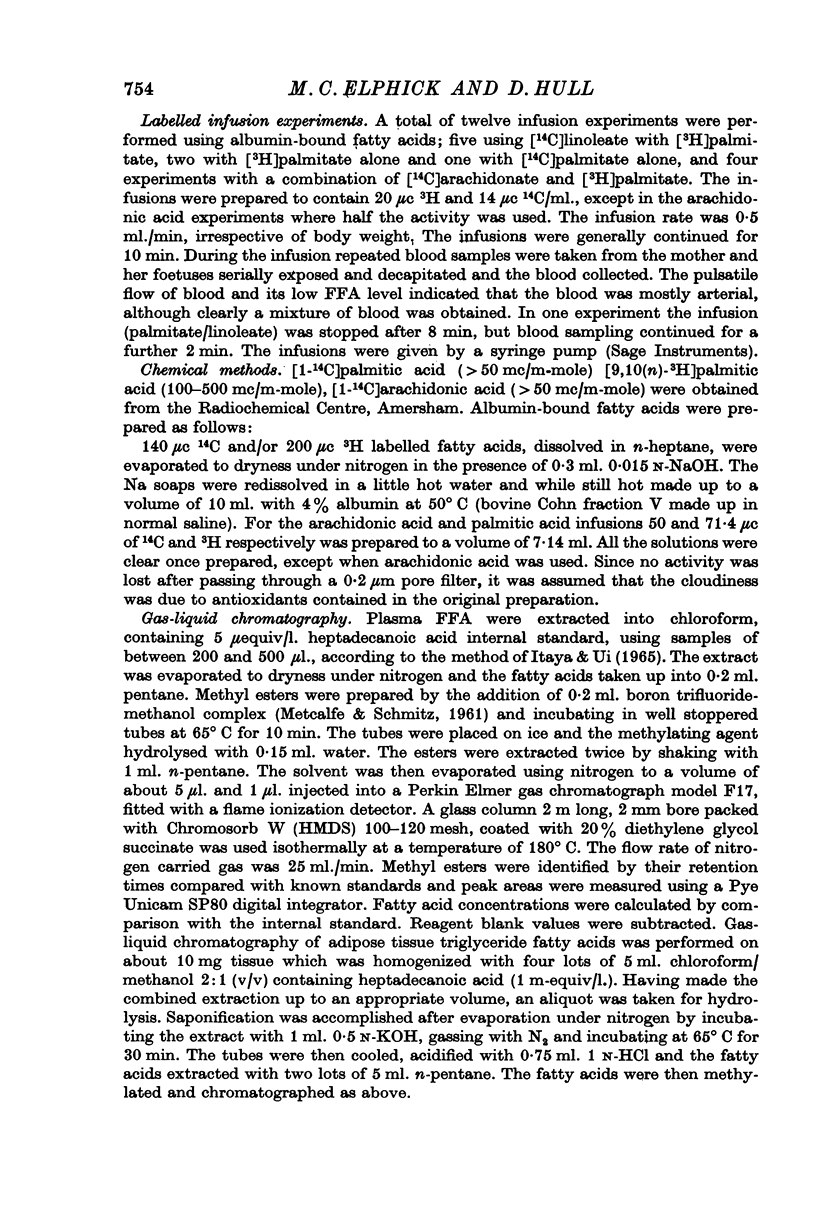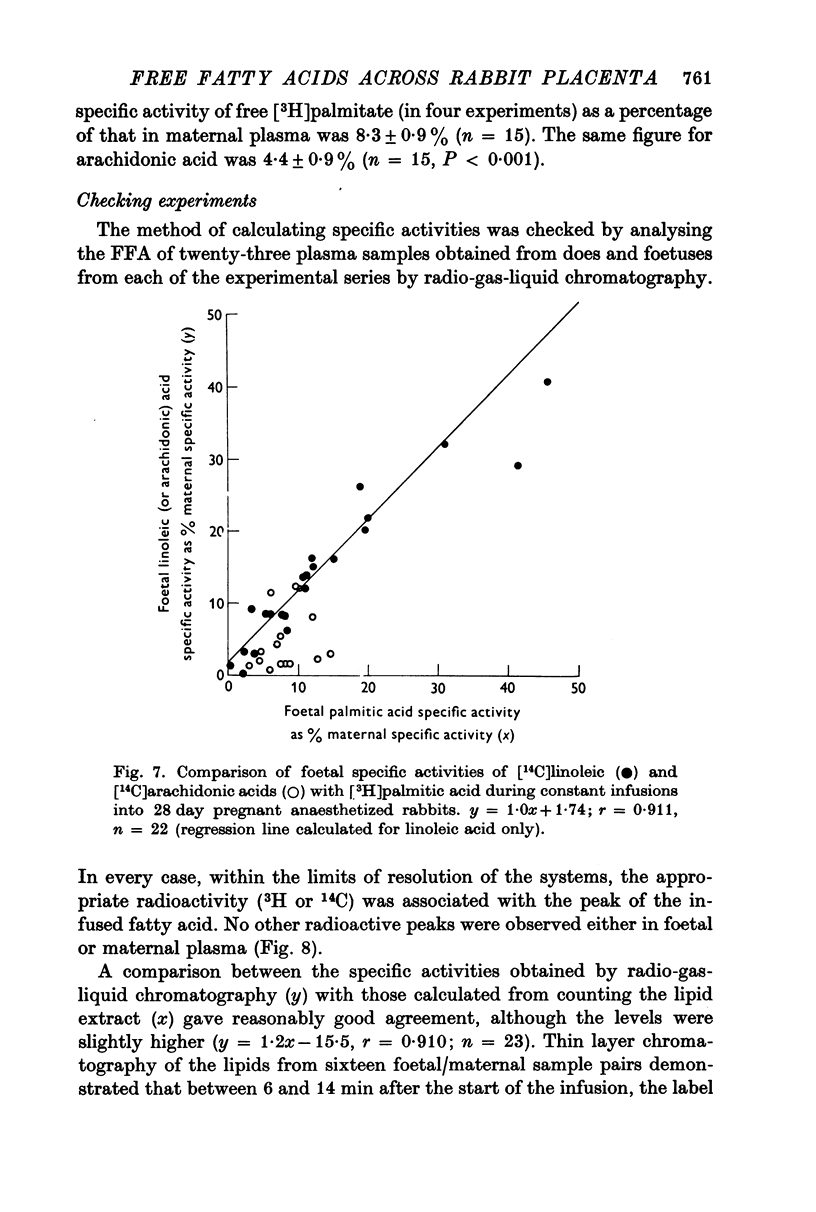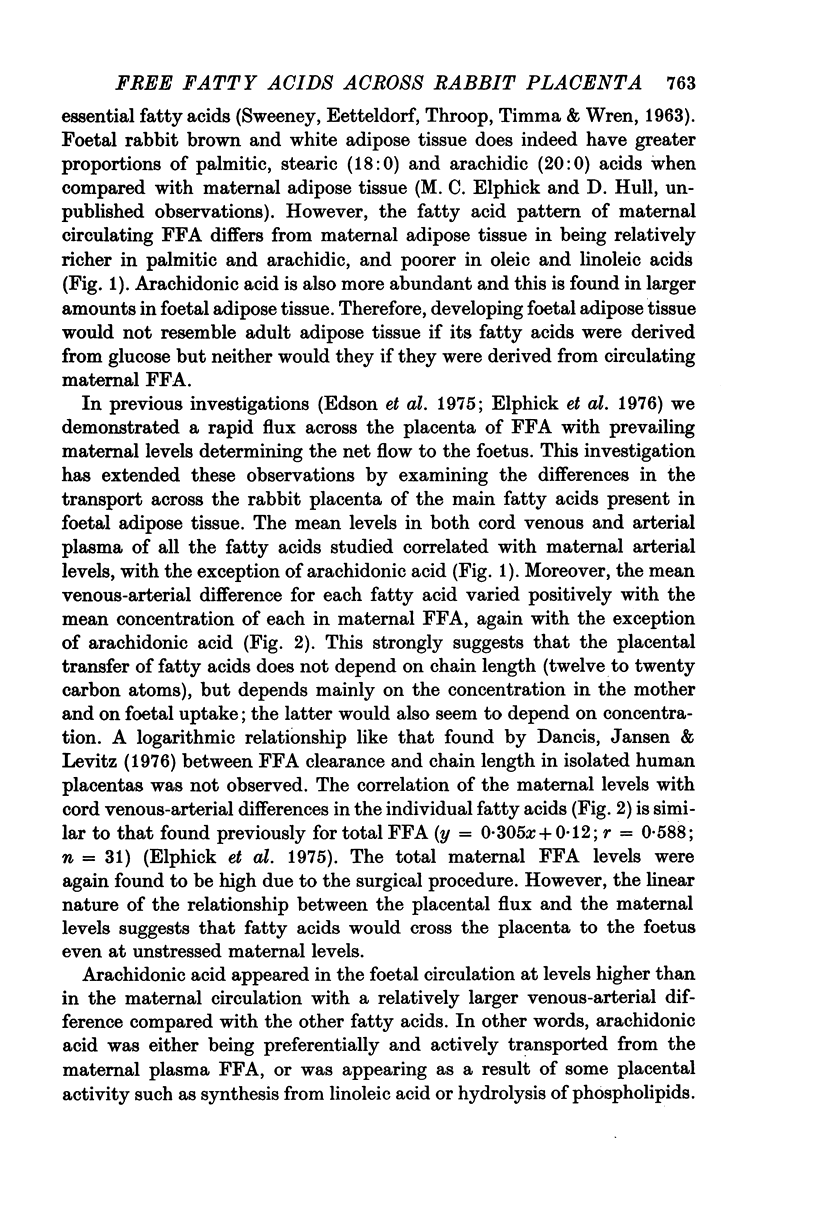Abstract
1. The passage of fatty acids across the placenta was studied in 28 day pregnant rabbits (i) by comparing the fatty acid distribution in plasma free fatty acids (FFA) of umbilical cord artery and vein with that in maternal plasma and (ii) by infusing the doe at a constant rate with labelled palmitic, linoleic or arachidonic acids. During the infusion maternal and foetal plasma FFA specific activities were measured. 2. The mean levels of all the fatty acids studied (from twelve to twenty carbon atoms) were similar in both the umbilical vein plasma and maternal arterial plasma FFA, except for arachidonic acid, which was higher in foetal blood. The relative distribution of the fatty acids in umbilical arterial plasma similar to that in the vein, but at lower concentrations. The mean cord venous-arterial difference for each fatty acid correlated positively with the mean maternal arterial levels, with the exception of arachidonic acid. 3. During the constant infusion experiments the specific activities of the fatty acids in the maternal and foetal circulating FFA pools rose rapidly during the first 4 min then rose only slowly. Palmitic and linoleic acids were cleared from the maternal circulation in a similar manner and crossed the placenta at similar rates. 4. The average foetal specific activity in plasma FFA reached 15% of the maternal level for both palmitate and linoleate. The figure for arachidonic acid was half that for palmitic acid infused at the same time. 5. It is concluded that (i) all the major fatty acids present in foetal adipose tissue cross the placenta, (ii) the net transport of each fatty acid depends in part on maternal concentrations, (iii) the rate of metabolism of palmitic and linoleic acids is the same and both cross the placenta at the same rate. Proportionately less foetal arachidonic acid is derived from maternal FFA, and (iv) the results suggest a second placental source of arachidonic acid and possibly also of otherfatty acids.
Full text
PDF















Selected References
These references are in PubMed. This may not be the complete list of references from this article.
- Bohmer T., Havel R. J. Genesis of fatty liver and hyperlipemia in the fetal guinea pig. J Lipid Res. 1975 Nov;16(6):454–460. [PubMed] [Google Scholar]
- Dancis J., Jansen V., Levitz M. Transfer across perfused human placenta. IV. Effect of protein binding on free fatty acids. Pediatr Res. 1976 Jan;10(1):5–10. doi: 10.1203/00006450-197601000-00002. [DOI] [PubMed] [Google Scholar]
- Edson J. L., Hudson D. G., Hull D. Evidence of increased fatty acid transfer across the placenta during a maternal fast in rabbits. Biol Neonate. 1975;27(1-2):50–55. doi: 10.1159/000240758. [DOI] [PubMed] [Google Scholar]
- Elphick M. C., Hudson D. G., Hull D. Transfer of fatty acids across the rabbit placenta. J Physiol. 1975 Oct;252(1):29–42. doi: 10.1113/jphysiol.1975.sp011132. [DOI] [PMC free article] [PubMed] [Google Scholar]
- Elphick M. C., Hull D., Sanders R. R. Concentrations of free fatty acids in maternal and umbilical cord blood during elective Caesarean section. Br J Obstet Gynaecol. 1976 Jul;83(7):539–544. doi: 10.1111/j.1471-0528.1976.tb00882.x. [DOI] [PubMed] [Google Scholar]
- FOLCH J., LEES M., SLOANE STANLEY G. H. A simple method for the isolation and purification of total lipides from animal tissues. J Biol Chem. 1957 May;226(1):497–509. [PubMed] [Google Scholar]
- Hershfield M. S., Nemeth A. M. Placental transport of free palmitic and linoleic acids in the guinea pig. J Lipid Res. 1968 Jul;9(4):460–468. [PubMed] [Google Scholar]
- Hummel L., Schirrmeister W., Zimmermann T., Wagner H. Studies on the lipid metabolism using 14C-1-palmitate in fetal rats. Biol Neonate. 1974;24(5):289–305. [PubMed] [Google Scholar]
- ITAYA K., UI M. COLORIMETRIC DETERMINATION OF FREE FATTY ACIDS IN BIOLOGICAL FLUIDS. J Lipid Res. 1965 Jan;6:16–20. [PubMed] [Google Scholar]
- James E., Meschia G., Battaglia F. C. A-V differences of free fatty acids and glycerol in the ovine umbilical circulation. Proc Soc Exp Biol Med. 1971 Dec;138(3):823–826. doi: 10.3181/00379727-138-35999. [DOI] [PubMed] [Google Scholar]
- Persson B., Tunell R. Influence of environmental temperature and acidosis on lipid mobilization in the human infant during the first two hours after birth. Acta Paediatr Scand. 1971 Jul;60(4):385–398. doi: 10.1111/j.1651-2227.1971.tb06677.x. [DOI] [PubMed] [Google Scholar]
- Portman O. W., Behrman R. E., Soltys P. Transfer of free fatty acids across the primate placenta. Am J Physiol. 1969 Jan;216(1):143–147. doi: 10.1152/ajplegacy.1969.216.1.143. [DOI] [PubMed] [Google Scholar]
- Sabata V., Wolf H., Lausmann S. The role of free fatty acids, glycerol, ketone bodies and glucose in the energy metabolism of the mother and fetus during delivery. Biol Neonat. 1968;13(1):7–17. doi: 10.1159/000240128. [DOI] [PubMed] [Google Scholar]
- Sheath J., Grimwade J., Waldron K., Bickley M., Taft P., Wood C. Arteriovenous nonesterified fatty acids and glycerol differences in the umbilical cord at term and their relationship to fetal metabolism. Am J Obstet Gynecol. 1972 Jun 1;113(3):358–362. doi: 10.1016/0002-9378(72)90684-9. [DOI] [PubMed] [Google Scholar]
- VAN DUYNE C. M., HAVEL R. J., FELTS J. M. Placental transfer of palmitic acid-1-C14 in rabbits. Am J Obstet Gynecol. 1962 Oct 15;84:1069–1074. doi: 10.1016/0002-9378(62)90556-2. [DOI] [PubMed] [Google Scholar]


